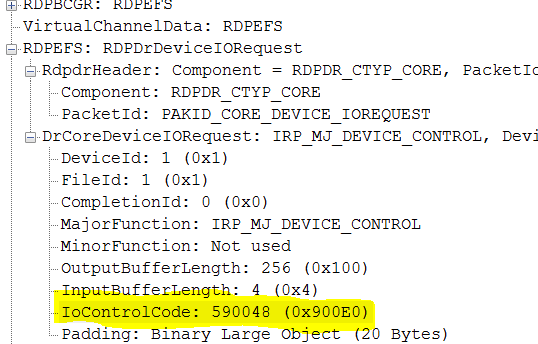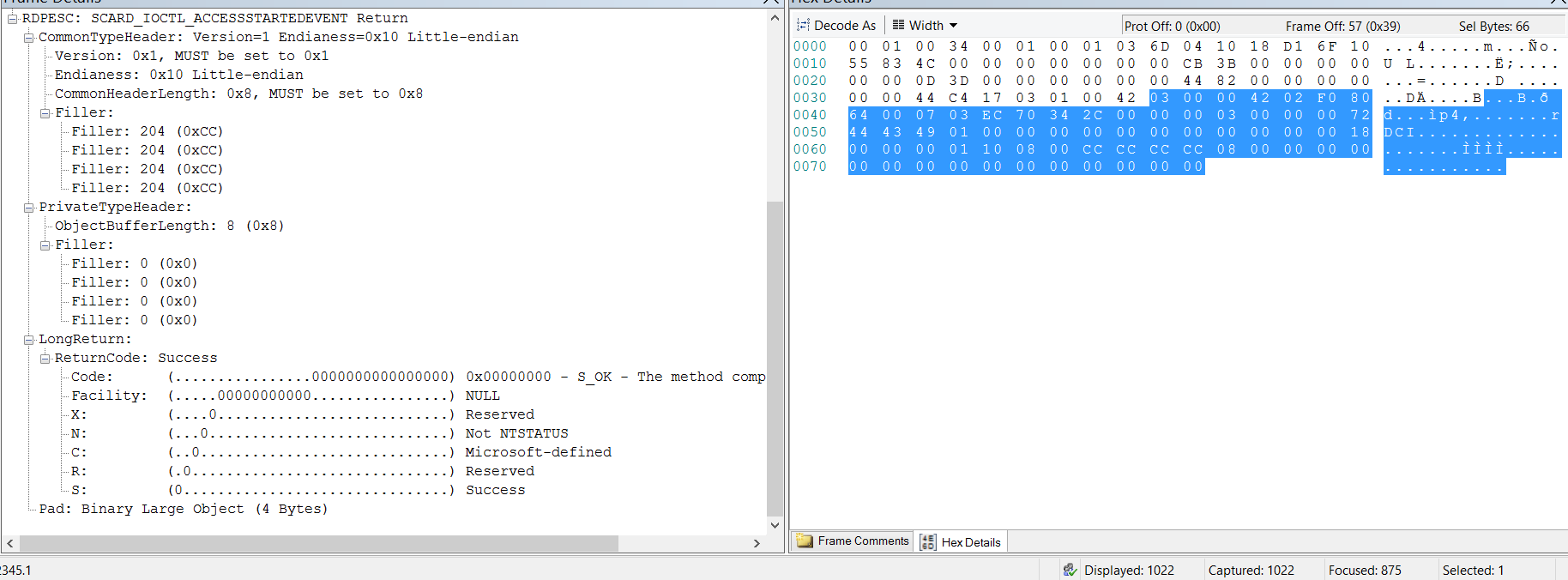RDPESC parser modification
Hello world!
I’ve decided to write this entry to talk about two
intertwined subjects:
- The published RDPESC parser needs a little tweak
in order to function properly
- That tweak is a real life example of how to
modify an existing Netmon Parser
My goal is not to rewrite the [MS-RDPESC]
document in this publication so I’ll be assuming that you are familiar with it
and will touch the protocol details just tangentially.
Introduction
I’ve recently worked on a case where a customer was
observing that Netmon 3.4
was not being able to decode some of the RDPESC packets correctly. The parser
was only going as far as the TLS layer and was taking the rest of the data as a
simple Blob.
This is pretty much what it looked like:
Easy case
The first thing that came to my mind was obviously that the
parser version the customer was using was stale so, I provided the link to the
latest and greatest version of Netmon parsers: 03.04.2978.0001.
Hold your horses!
Although customer was happy with the way the newer version
of the parsers was handling the RDPESC structures… there was something not
working…
This is what the same frame looked like with the plain
vanilla new parsers:
As we can see, this is day and night compared with not
having anything parsed below TLS.
But… and there’s always a “but”, look at the RDPESC packet
itself. There’s something wrong…
This is what other RDPESC packets look like (other control
codes that is):
Don’t lose your headER!!!
Different calls and returns contain different data (duh!)… Even
different headers sometimes! (hmmm)
But, shouldn’t packets ALWAYS have a header?!?!
(What? What red pill? Oh…. Ok… lots of water? Ok, here it
goes…)
Sorry, my friend Morpheus was talking to me.
As I was saying, even though there might be protocols that
do not have a properly design header structure, RDPESC is not one of those and
its packets do indeed possess a header.
So, what could possibly go wrong with the parser that it is
treating one return call differently from another return call?
Welcome to "The Parserix"…
If we right click on the RDPESC call return and
select “Go To Data Type Definition”, the RDPESC parser file opens up and the
first thing we can see is this:
At first sight, having a “switch” clause is a good sign. It
wouldn’t be the first time someone misses a case in a switch clause… would it?
Although the above mentioned is a very common scenario, it
was not the EXACT case this time around.
Because of the way the RDPESC parser works, we need to look
at the initial call’s control code in order to figure out which of the
scenarios it is that we are dealing with.
I present you with the control code for SCARD_IOCTL_ACCESSSTARTEDEVENT:
Once the control code has been identified, we can then see
that 0x900E0 is a special case on the RDPESC parser world:
All fine and dandy but, what’s wrong?
Well, basically the document specifies in section 3.1.4
that:
“6. Otherwise,
DR_DEVICE_IOCOMPLETION.IOStatus MUST be set to 0 (STATUS_SUCCESS) and
DR_DEVICE_IOCOMPLETION.Parameters.DeviceIOControl.OutputBuffer MUST contain an
encoding of the structure (as specified in the preceding Message Processing
Events and Sequencing Rules IOCTL Table) as specified in [MS-RPCE] section 2.2.6. DR_DEVICE_IOCOMPLETION.Parameters.DeviceIOControl.OutputBufferLength
is the length of the data.”
That means that the return call is to be parsed WITH an
MSRPCHeader.
So, we need to modify the parser.
MUST… MODIFY… PARSER…
So in order to make this change to the parser, we can follow
either of the two main ways we know we can use to modify parsers:
- We can either add a personalized copy of the
parser to some “myparsers” folder and then set that folder as the first option
in the list of precedence in the current profile OR
- We can replace the existing RDPESC parser from
the Windows profile in Network Monitor with an updated version of it.
In this case, we’ll use the second approach.
These are the steps:
1) Navigate to “C:\ProgramData\Microsoft\Network
Monitor 3\NPL\NetworkMonitor Parsers\Windows”
2) Save a copy of rdpesc.npl to a safe location
3) Open the original file with a text editor
4) Replace:
// SmartCardCall W/O MSRPCHeader
case 0x000900E0:
switch(property.RDPEFSPacketId)
{
case 0x4952:
UINT32 Unused;
case 0x4943:
RDPESCLongReturn LongReturn;
}
5) With:
//
// SmartCardCall (Special case, see below)
//
case 0x000900E0:
switch(property.RDPEFSPacketId)
{
case 0x4952:
//
//The "Call" does NOT have a RPCHeader
//
UINT32 Unused;
case 0x4943:
//
// Whereas, the "Return" does (so, handle the same way as all the other
IOCTLs)
//
_struct RDPESCSmartCardCallWithMSRPCHeader
{
RPCECommonTypeHeader CommonTypeHeader;
RPCEPrivateTypeHeader PrivateTypeHeader;
RDPESCLongReturn LongReturn;
}
}
6) Save the file back to its original place
Once the modification has been made, reopen the
capture in Network Monitor and look at the results. The return call should now
look like this:
Conclusion
“It is done!”
PS: I was going to be more wordy for the conclusion of this entry but I figured out that
the post was pretty much self-explanatory.
BTW, if you want to learn some more details regarding parser modifications, you
can take a peek at my co-worker’s entry from some time ago: https://blogs.msdn.com/b/openspecification/archive/2011/08/08/customizing-in-box-netmon-parsers-how-to-edit-and-deploy-updated-netmon-parsers.aspx






